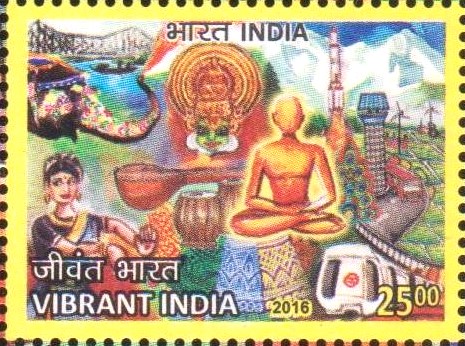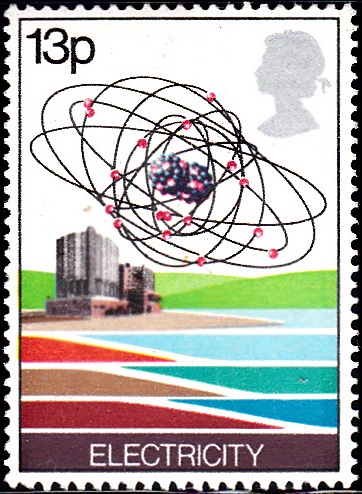
Vibrant India 2016
A Miniature Sheet consisting of 1 no. of special postage stamp on the Vibrant India, an Government of India initiative :

 Issued by India
Issued by India
Issued on Jan 25, 2016
Issued for : The Department of Posts organized a nation-wide competition inviting entries for designing the commemorative souvenir sheet, First Day Cover and Brochure on the theme “Vibrant India”. Based on selected entries a souvenir sheet, First Day Cover and Brochure, on the theme, are being released. Approximately 1000 entries were received from all over the country.
Design : The designs on the Souvenir Sheet, First Day Cover & Brochure are based on the entries submitted by Ms. U Mangala Nayak, Ms. Nisha Verma, Ms. Srishti Jain, Ms. Rashmi Singh Rathaur, Ms. Annu, Ms. Charvi Khurana, Ms. Prerna, Ms. Binita Bishwajeeta, Ms. Nivedha Selvaraj and Ms. Shalini Shashikant Hudpane.
Credits :
Souvenir Sheet / FDC / Cancellation Cachet : Smt. Nenu Gupta, based on selected paintings submitted by participants.
Type : Souvenir Sheet, Mint Condition
Colour : Multi Colour
Denomination : 2500 Paise
Souvenir Sheet Printed : 0.3 Million
Printing Process : Wet Offset
Printer : Security Printing Press, Hyderabad
About :
- India is one of the oldest civilizations in the world with a varied and rich cultural heritage. It has achieved all-round socio-economic progress during the last 67 years of its Independence. Lying entirely in the northern hemisphere, the mainland extends between latitudes 8° 4’ and 37° 6’ north, longitudes 68° 7’ and 97° 25’ east and measures about 3,214 km from north to south between the extreme latitudes and about 2,933 km from east to west between the extreme longitudes. It has a land frontier of about 15,200 km. The total length of the coastline of the mainland, Lakshadweep Islands and Andaman & Nicobar Islands is 7,516.6 km.
- The Indian peninsula is separated from mainland Asia by the Himalayas. The Country is surrounded by the Bay of Bengal in the east, the Arabian Sea in the west, and the Indian Ocean to the south. The mainland comprises of four regions, namely the great mountain zone, plains of the Ganga and the Indus, the desert region, and the southern peninsula. Natural resources such as lakes, rivers, forests, wildlife, etc. have a pivotal role in Indian lifestyle and the growing population of the country has been increasing pressure on environment. The primary concern of the government is to implement policies and programmes for conservation of the ecosystem, natural resources, welfare of animals and prevention of pollution etc. and numerous initiatives have been taken by the government and various organizations for conservation and protection of flora and fauna, forest and wildlife, and for control of pollution.
- Culture plays an important role in the development of any nation. It represents a set of shared attitudes, values, goals and practices. Culture and creativity manifest themselves in almost all economic, social and other activities. A country as diverse as India is symbolized by the plurality of its culture. India has one of the world’s largest collections of songs, music, dance, theatre, folk traditions, performing arts, rites and rituals, paintings and writings that are known, as the ‘Intangible Cultural Heritage’ (ICH) of humanity. In order to preserve and promote these elements, the government has been implementing a number of schemes and programmes aimed at providing financial support to individuals, groups and cultural organizations engaged in performing, visual and literary arts etc.
- The essence of Human Resource Development is education, which plays a significant and remedial role in balancing the socio-economic framework of the country. Rising to this challenge, the country has been taking huge and far reaching initiatives in the field of elementary, secondary, higher secondary, higher technical and adult education. There has been a growing emphasis on vocational trainings in the country with a view to development of not just an educated, but a skilled workforce.
- Agriculture, with its allied sectors, is unquestionably the largest livelihood provider in India, more so in the vast rural area. It also contributes a significant figure to the Gross Domestic Product (GDP). It is recognized that sustainable agriculture, in terms of food security, rural employment, and environmentally sustainable technologies such as soil conservation, sustainable natural resource management and biodiversity protection, are essential for holistic rural development, and numerous initiatives have been taken in the country in this regard. Indian agriculture and allied activities have witnessed a green revolution, a white revolution, a yellow revolution and a blue revolution.
- Infrastructure is a major sector that propels overall development of the Indian economy. The government is involved in initiating policies that would ensure time-bound creation of world class infrastructure in the country. These initiatives focuses on power, bridges, dams, roads and urban infrastructure development. Power and Energy are recognized as two essential inputs for economic development and improving the quality of life in India. Development of both conventional and non-conventional forms of energy for meeting the growing energy needs of society at a reasonable cost is a challenge. Special initiatives have been taken and are being taken by the Union and state governments in this regard and for promoting the use of non-conventional/alternate/new and renewable sources of energy such as solar, wind and bio-energy, etc.
- Science and Technology have always been an integral part of Indian culture. Natural philosophy, as it was termed in ancient times, was pursued vigorously at institutions of higher learning. The Indian Renaissance, which coincided with our struggle for Independence, witnessed great strides made by Indian scientists. This innate ability to perform creatively in science came to be backed with an institutional setup and strong state support after the country’s independence in 1947. The Government of India has worked towards establishing a modern Science and Technology infrastructure in the country. Scientific education and scientific research & development has been on a steady rise as a result of all these initiatives.
- Text : Based on material available on the internet.







